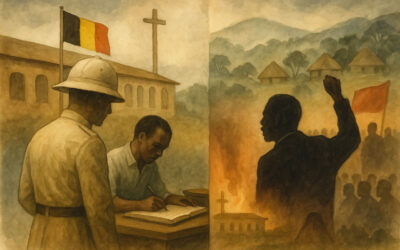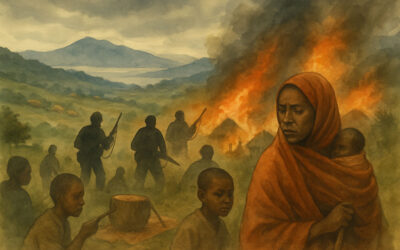Colonel Aloys Ntiwiragabo was found near Orléans in 2020, having evaded international justice for 26 years. He was not in Rwanda when the president’s plane was shot down on 6 April 1994. However, he and his subordinates were involved in every aspect of the plot. First episode.
On the evening of 6 April 1994, the Rwandan capital, Kigali, became the scene of a deadly plot. Two missiles, fired from an army camp, shot down the presidential plane as it prepared to land. Head of State Juvénal Habyarimana and his Burundian counterpart Cyprien Ntaryamira, who was travelling with him, were among those killed in the attack. Meanwhile, on the ground, the Rwandan military committed a series of political assassinations, creating a constitutional vacuum and seizing power. This was the starting signal for a long-planned collective crime, the genocide of the Tutsi, which claimed a million lives over the following three months.
African Facts investigated the role of Aloys Ntiwiragabo, then head of military intelligence and now a resident of France, during the first 24 hours of the last genocide of the XXth century. A carefully and methodically orchestrated conspiracy.
The troubling absence of the colonel on 6 April 1994
Aloys Ntiwiragabo was not in Kigali on 6 April 1994. He had been attending a two-day meeting of the United Nations Standing Advisory Committee on Security Questions in Central Africa (UNSAC) in Yaoundé (Cameroon). The Rwandan Minister of Defence joined him in the Cameroonian capital, arriving just half an hour before the attack.
Military and political tensions were running high in Rwanda, where a fragile truce applied and threats to the president’s life, made publicly and known to all, were intensifying. However, these two key figures in the security apparatus defied logic by leaving to attend a meeting in which the Rwandan issue proved to be completely marginal, as evidenced by the official UNSAC report and the Cameroonian daily press at the time.
According to a “special report” by UNSAC secretary Sammy Kum Buo, seen by African Facts, the Rwandan delegation in Yaoundé had a telephone link with Rwanda, enabling them to monitor the situation closely. Were Colonel Ntiwiragabo and the minister aware of what was happening that night? In any case, they clearly had an idea of how events would unfold in Rwanda, as Sammy Kum Buo writes in his report: “From the moment my colleagues in the secretariat and I broke the news to the two delegations that same night, long before news of violent reactions had been received from Kigali, the members of the Rwandan delegation […] predicted it”.
During our investigation, we discovered other evidence indicating that Aloys Ntiwiragabo had detailed knowledge of the events unfolding in the capital.
In 2018, two years before his presence in France was discovered, the Central Office for the Fight against Crimes against Humanity (OCLCH) intercepted a brief telephone conversation relating to another case. African Facts was able to consult the transcript. At the time, the investigators did not know that they were listening to Aloys Ntiwiragabo. His interlocutor mentioned the case of a Rwandan officer who had provided the International Criminal Court with information about meetings held during the first days of the genocide.
– The one attended by Bagosora [one of the main perpetrators of the genocide Ed.], and everyone… So that they could set up a government — this meeting that took place… I don’t know what it’s called.
– The meeting… There was a meeting held at night.
– That’s right!
– And in the morning, they set up a crisis committee because of the meeting that had taken place the night before.
– Tere you go!
– [The informant] was not present at any of these crisis meetings.
This is a very curious statement from Aloys Ntiwiragbo, who consistently claimed in 1995, 1997, 2018 and 2020 that he was absent from the capital at the time, implying that he was unaware of the situation and not responsible. Was the colonel being kept informed of unfolding events by his department, as the UNSAC special report also seems to suggest?
And curiously, while Aloys Ntiwiragabo was not physically present in Kigali that night, the G2 department he headed was omnipresent behind the scenes of the plot unfolding in the capital.
A multi-layered plot
On 6 April 1994, changes were made to the radio frequencies used by the Rwandan army. Although this was a routine exercise, it temporarily disrupted the military by isolating certain operators from each other and forcing them to contact headquarters, thereby centralising communications. The officer on duty at headquarters on the night of 6–7 April, was Aloys Ntiwiragabo’s deputy in the G2 service.
Two hours after the attack on the presidential plane, this same deputy took part in the “crisis committee” that endorsed the military coup: the “meeting held at night”. In the hours that followed, the army assassinated the prime minister, the president of the constitutional court, and the main opposition politicians.
Immediately after the attack, the Rwandan army’s Commandos de recherche et d’action en profondeur (CRAP, an elite special unit) went to the crash site, accompanied by several French military aid workers. They carried out searches. Several pieces of evidence disappeared that night, including the aircraft’s flight data recorder, which would have enabled the accident to be investigated and the origin of the shots to be determined. According to a 1993 document signed by Aloys Ntiwiragabo himself and obtained by African Facts, “the use of CRAP in intelligence gathering” was the prerogative of the G2.
At dawn on 7 April 1994, ten Belgian peacekeepers who were protecting the country’s prime minister were captured and taken to a military camp, where they were summarily executed. This triggered the withdrawal of Belgian troops from the United Nations Mission in Rwanda (MINUAR). African Facts examined documents written by the armed forces at the time. Two G2 non-commissioned officers were present at the location where the ten Belgian soldiers were held briefly before being massacred. Aloys Ntiwiragabo’s deputy at G2 could see the bodies from the operations room of the general staff. The officer who was later found guilty of the murders by Belgian courts had been the G2 correspondent on the front line a few months earlier.
This particular assassination appears to have been premeditated. Two days before the coup, Colonel Aloys Ntiwiragabo was flying to Cameroon when a lieutenant in the gendarmerie allegedly encouraged other junior officers to attend a reception organised by the prime minister. That same evening, the media outlet of the Génocidaires, Radiotélévision libre des mille collines (RTLM), accused the head of government of conspiring with them and preparing a military coup, justifying her elimination in advance in the early hours of 7 April.
As the killings multiplied in the capital, the G2 implemented another important part of the plot. A staging designed to mislead public opinion, divert attention, and exonerate the conspirators.
On the morning of 7 April, the G2’s interception station claimed to have intercepted a message from the rebels claiming responsibility for the attack. In reality, the message was a forgery of their own design. The radio operator who transcribed the fake message is unequivocal. “The sector commander personally brought me the fake message to transcribe. The text was handwritten on a piece of paper. Its author was my superior, Colonel Aloys Ntiwiragabo. I was perfectly capable of distinguishing their respective handwritings”, he said. A note dated 17 November 1993 and signed by Ntiwiragabo, which was revealed by Mediapart, shows that he predicted the content of the message several months before it was broadcast.
The genocidaires soon claimed that rebels had shot down the plane from a hill near the airport. They cited photographs of two missile launchers found at the scene as proof. This turned out to be a fabrication, too. Once again, the G2 was behind the manipulation. Years later, Colonel Aloys Ntiwiragabo himself attributed authorship of these photographs to his service when a French judge came to interview him in Congo.
The genocidaires soon claimed that rebels had shot down the plane from a hill near the airport. They cited photographs of two missile launchers found at the scene as proof. This turned out to be a fabrication, too. Once again, the G2 was behind the manipulation. Years later, Colonel Aloys Ntiwiragabo himself attributed authorship of these photographs to his service when a French judge came to interview him in Congo.
Ntiwiragabo did return to Rwanda, but not until 8 April 1994, when he continued to serve as head of military intelligence. From the end of May 1994, he also served as commander of the Kigali “operational sector”. He is currently under investigation by the National Anti-Terrorism Prosecutor’s Office (PNAT) and the OCLCH for his alleged role in the genocide that claimed a million lives between April and July 1994. He is presumed innocent. Solicited, his lawyer asked us to “stop bothering” his client.
Who was Ntiwiragabo in telephone contact with in Yaoundé on 6 and 7 April 1994? Was it the Ministry of Defence, which at that time was under the control of the extremist leader Colonel Théoneste Bagosora, or the Rwandan army headquarters, where his deputy was on duty? The investigation should seek to answer these crucial questions to shed light on Aloys Ntiwiragabo’s role in these events and his level of involvement and responsibility in the plot.



